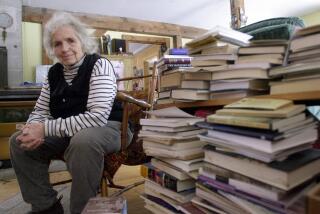Cries and Whispers
- Share via
Ten years ago, as the Cold War came to an end, one of the most complicated questions facing governments throughout the world had nothing to do with nuclear arsenals or political realignments. The most complicated question had to do with torture: As dictatorships gave way to democracies, no one was quite sure how to treat the people who, guilty of such heinous crimes, now walked the streets with their victims.
Ten years later, and with the publication of “The Good Listener,” Neil Belton makes it clear why it was easier at the time to think about the torturers than about the innocent. Belton’s book is the story of Helen Bamber, one of the world’s preeminent advocates for the victims of torture, and in recounting the details of her life, he offers a history of human rights abuses that have riddled the latter half of this century, making it clear how difficult it is to look into the eyes of the men and women and children whose lives have been shattered by the capricious power of the state. “I have tried to give a stand against cruelty the force of a human story,” Belton writes. He succeeds remarkably.
Bamber is the director of the London-based Medical Foundation for the Care of Victims of Torture, an organization she founded 14 years ago at the age of 60. The foundation is the culmination of a lifetime of work championing the rights of the world’s most disenfranchised people. First a member of the Jewish Relief Unit in postwar Germany, then a case worker for refugee children from the concentration camps and finally a driving force behind Amnesty International in the 1960s and ‘70s, she has witnessed the effects and helped ease the suffering of some of the worst crimes committed in the world. At a time when we wrestle over the question of evil in the world, she makes us consider the more puzzling presence of good.
Seventy-four years old, Bamber steadfastly refuses to accept the world as it is. “What I find difficult, and always have, is how easily we become bystanders,” she says. “A whole structure of power, even in those states that don’t themselves torture, seems to find it necessary to support, or at least not confront, torture states.”
Bamber grew up in the 1930s in north London, the only child of bitterly unhappy parents in a politically charged Jewish community. Her instinct for activism took her to Germany in the fall of 1945 with the Jewish Relief Unit when she was 20. She was stationed in the British Occupation Zone, a dreary landscape still haunted by the tens of thousands who died at nearby Bergen Belsen. Administrator of the Jewish Relief Unit, Bamber set out to help nearly 12,000 displaced Jews not only to find new lives for themselves but also to cope with the terrible memories of their past.
Upon returning to England, she spent years quietly searching for something that she could believe in and act upon. She married. She worked with refugees from the camps. She had two children. She was a hospital administrator. She divorced. She campaigned within the medical establishment for patient rights. She raised her children and became a principal activist behind a fledging human rights organization, Amnesty International.
Her campaign against torture began in the early 1960s and focused on France’s treatment of prisoners in Algeria. In the ‘70s and ‘80s, she worked for the disappeared in Latin America. She has been moved throughout her life, Belton suggests, “by the universalistic ideas that flourished as the war ended, as were so many young people: racism, fascism and barbarism can be overcome; evil need not triumph; this must never happen again.”
In the 1980s, as infighting erupted at Amnesty International, she began to recognize a greater need for the treatment, not just advocacy, of the victims of torture. When the foundation opened in 1985, she and the doctors who hired on saw 600 people a year; by 1997, the numbers had jumped to 2,000 a year. Her genius lay in her ability to recognize the unique needs of these individuals and develop a set of protocols that would help bring them back into the world.
The work at the foundation is best understood as the political application of psychotherapy. Belton recounts the stories of patients to show how specialized the needs of torture victims are. Beneath the scars are deep psychological wounds that have not yet healed.
Speaking is extraordinarily difficult for most survivors, who are profoundly estranged from the world. Their lives are like jigsaw puzzles, requiring a slow and meticulous reconstruction. The process begins with an understanding of their bodies, the torturer’s target and entrance into their minds, and focuses on the pain they have felt, its origins and its depth. One doctor describes an examination as an “entering-in”: “You have to move into the torture chamber with them. . . . Each question makes the situation less ambiguous and clearer. Were you wearing a blindfold? Were you seated? Was there a light?”
“The healer,” Bamber explains, “must find out, but not like an inquisitor. Help can begin with the act of listening, for nothing else leads to an understanding of the speaker’s true situation. Careful attention to the voice and the body can honor the memory of pain, and begin the process that turns memory and description into a refusal of the destructive power of that pain.”
Because torture typically distorts the way the body and mind work, survivors suffer from a variety of psychosomatic complaints. Bamber explains that victims typically dissociate their physical selves from their mental selves, so that the treatment of pain can be quite elusive. Back pain is most common and cannot be effectively treated by an osteopath until the doctor understands the mind that experienced the discomfort and the meaning of the words that describe it. The process is made all the more difficult because memories too have become altered. In order to endure pain, victims typically erase whatever comfort, love or familiarity they once knew, lest their memory add to their agony. The key to treatment ultimately involves reconnecting victims to their bodies and their pasts, which is sometimes--and sometimes not--successful.
*
The foundation is also a human rights organization, publicizing instances of torture rallying against governments that place limits on asylum; denouncing the export of electric-shock batons, restraints and generators; and providing expert witnesses in trials in which torture is an allegation. Bamber has recently testified against the state of Israel for its treatment of Palestinians.
And when the question of reconciliation comes up--what seemed 10 years ago so important--she becomes noticeably angry. “I don’t know what reconciliation means; forgiveness can only be given if someone actually asks for it. . . . You have to place torture in a proper context,” she says. “Otherwise, you are not actually honoring the people who have suffered, you are merely looking at a body that has been assaulted or mutilated. . . . [I]t’s about power, about privilege, about poverty and the distribution of resources; it’s about something which is most preventable.”
More than 50 years after the Charter of the United Nations of 1945 and the Universal Declaration of Human Rights of 1948, Bamber reminds us of the vow that followed World War II: Never again. The timing is right: Today more people live under governments that practice torture than governments that don’t. Though it may be understandable that the fate of torturers seemed more significant than the lives of their victims--willful forgetfulness of the unchampioned and abused is, after all, the tragic hallmark of the century--Belton and Bamber remind us that the treatment and the fate of the individual, the solitary man or woman lying in prison, has the greatest power to subvert and degrade the moral life of the state. Belton may call “The Good Listener” a footnote to the last 50 years of human rights abuses, but it is far more. Driven by Bamber’s passion and his own intelligent assessment of the history, Belton has written a valuable call to action.
More to Read
Sign up for our Book Club newsletter
Get the latest news, events and more from the Los Angeles Times Book Club, and help us get L.A. reading and talking.
You may occasionally receive promotional content from the Los Angeles Times.











